8.6 /10 1 Votes8.6
6.9/10 GameSpot Director(s) Kenji Kikuchi Composer(s) Aya Tanaka Initial release date 10 November 2003 | 4.7/5 Emuparadise 4.6/5 eBay Designer(s) Shinichi Nakata Genre(s) Party | |||||||||||||||||||||||||||||||||
 | ||||||||||||||||||||||||||||||||||
Producer(s) Hiroshi SatoAtsushi Ikeda Modes Single-player video game, Multiplayer video game Similar Mario Party games, Party games, Other games | ||||||||||||||||||||||||||||||||||
Mario party 5 all minigames
Mario Party 5 (Japanese: マリオパーティ5, Hepburn: Mario Pāti Faibu) is a party video game developed by Hudson Soft and published by Nintendo. It is the second game in the Mario Party series for Nintendo GameCube. It was released in North America on November 10, 2003; in Japan on November 28, 2003; and in Europe and Australia on December 5, 2003. Mario Party 5 is the fifth installment in the Mario Party series.
Contents
- Mario party 5 all minigames
- Mario party 5 part 01 4 player
- Gameplay
- Plot and setting
- Development
- Reception
- References
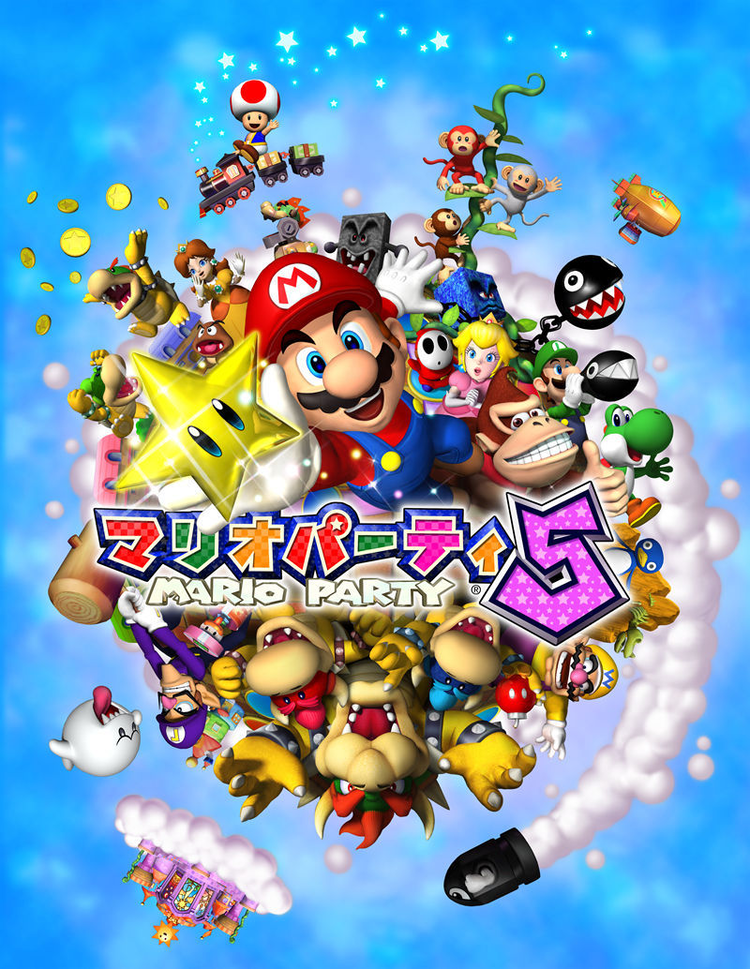
The game is set in the fictional world of the Dream Depot, consisting of seven game boards. The single-player "Story" mode involves the player winning multiple games against the Koopa Kids to prevent Bowser from conquering the Dream Depot. The main multiplayer game mode consists of four characters from Mario series playing a board game, with each board having a set theme. The game also features several minigames, which are played after every set of turns. Mario Party 5 introduces the "Super Duel" mode to the franchise, which requires players to assemble and control custom made battle vehicles which can be used in combat against other machines. The game features ten playable characters, with playable debuts to the series from Toad, Boo, and Koopa Kid.
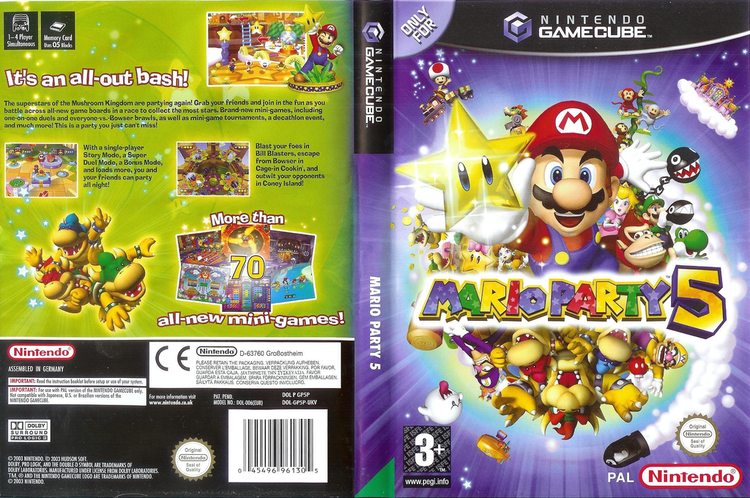
Mario Party 5 received "average" reviews by the media; reviewers enjoyed the new minigames of the series, although a perceived lack of originality was criticized. The game became part of the Nintendo Player's Choice label in 2004, and won the Console Children's Award at the 2004 Interactive Achievement Awards.

Mario party 5 part 01 4 player
Gameplay
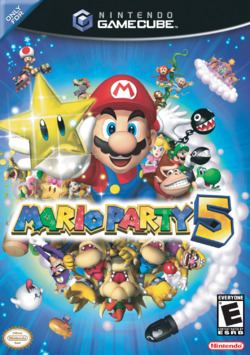
Mario Party 5 retains the fundamental gameplay featured in previous installments, which is based upon a themed board game played by characters of the Mario series. The player's objective is to obtain the most stars by the end of the board game, which are usually purchased when passing the designated star space on the game board. Coins are earned mainly by winning minigames, which occur after all players have rolled the die. "Party Mode" is the main multiplayer mode, and involves four characters competing in a standard board game either independently or in opposing pairs. As with its predecessors, players can adjust the number of turns in a game by multiples of five, and determine the difficulty of artificial intelligence opponents, among others.
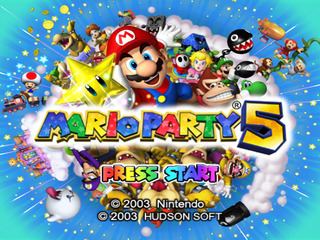
Mario Party 5 features ten playable characters, including three additional characters to the series: Toad, Boo, and Koopa Kid. Hudson omitted Donkey Kong as a playable character from the series in this installment, instead featuring him in the "DK space", which initiates an event granting the possibility of a star or coins whenever landed on. Like previous installments, blue and red spaces add or deduct three coins from players when they land on them. "Bowser spaces" return from Mario Party 4. While the series' predecessors used item shops as a means to obtain items, Mario Party 5 introduces the capsule system. Capsules are containers that hold a single item which are acquired when passing the "Capsule Machine" on the board. The items contained within them serve a variety of purposes, from increasing the range of the die and thus movement, to deducting ten coins from an opponent. The capsules can only be thrown up to ten spaces ahead of the current position. During a game, the gameplay is altered for the last five turns with the options selected randomly via a roulette wheel; such changes include tripling the coin benefit or deficit from coloured spaces.

The game's boards incorporate the theme of the Dream Depot, with each having "Dream" at the end of the board's title, except for the "Bowser's Nightmare" board. Themes of the boards include dreams of toys and treasure hunting, among others. Each board consists of multiple types of spaces, some of which grant special types of minigames that cannot be accessed regularly. Some spaces, specifically "happening" spaces, will incorporate the relevant theme; for example, a giant robot resembling Mecha Bowser will shoot any character back to the start when landing on its "happening" space in the Toy Dream board.
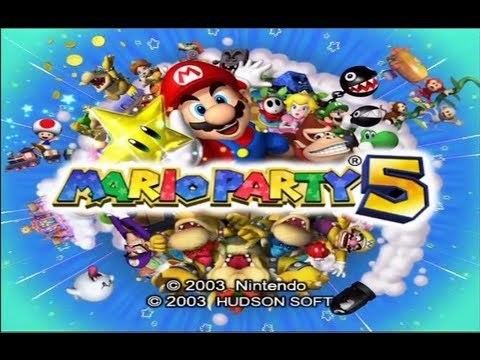
Players can choose to play minigames separate from the board game context via "Minigame Mode". The minigames are categorized by their character structure, with "4-player", "1 vs. 3", and "2 vs. 2" available. Besides these standard versions, there are also the "DK" and "Bowser" minigames, which are themed to reflect their titular character; "Battle" minigames are retained from the previous three Mario Party games. "Duel" minigames, which involve two players competing against each other, are re-introduced. The set of minigames are available without a structure ("Free play") in this mode, but can be formatted into tournaments and separate objectives like in "Mini-game circuit", involving the characters winning minigames to reach the finish line first. A total of 75 minigames can be played, but they all must be unlocked via "Party mode" and "Story mode" before they can be played in "Minigame Mode". In "Bonus mode", a set of three larger games that do not appear in usual play can be accessed; this involves a card-based board game ("Card party"), as well as Beach volleyball and Ice hockey.
Mario Party 5 introduced the "Super-Duel Mode", a game involving the player assembling and controlling a combat vehicle. Each component of the vehicle can be bought separately; these do not necessarily have to fit with other parts stylistically, and contribute to the vehicle's general statistics regarding fields such as health and speed. Once the vehicle is assembled and named, it can engage AI or human opponents in a single match or in tournaments. Variants of this are available, including a capture the flag mode and another requiring the player to shoot mechanical rabbits.
Plot and setting
The story mode in Mario Party 5 is completely different from the story modes of Mario Party 3 and Mario Party 4. Players face three Koopa Kids (red, green, and blue). The only way to defeat them and clear the board is to take all their coins away, mostly by beating them in minigames. Players must take all coins from a Koopa Kid to defeat him. If players lose all of the coins or don't defeat the Koopa Kids within fifteen turns, the game is over. After players win five boards, they face Bowser in a final stage mini-game called "Frightmare", which is a one-on-one mini-game with Bowser. There are four parts to the battle. First, players go against Mechakoopas (robotic versions of Koopa Troopas). Next, players have to move and jump around to avoid three rings of fire for a short time. Then players face Bowser directly; they must make him jump onto a tile three times to clear the third part. The final part of the minigame is the final battle, where Bowser grows. After throwing fireballs and hitting Bowser with them five times, the game is cleared and the final board is unlocked.
Development
Like its predecessors, Mario Party 5 was published by Nintendo and developed by Hudson Soft. It is the first Mario Party game to have Donkey Kong as a non-playable character. It is also the first Mario Party game to have Wario wearing his current short-sleeve shirt. It is the last Mario Party game where Daisy is voiced by Jen Taylor; for later games, Jen Taylor is replaced by Deanna Mustard. It is the fifth and final Mario Party game to have Bowser's sound effects from the first four Mario Party games.
Nintendo first unveiled the game at the E3 conference of 2003, where eight mini-games were available in a playable demonstration. Following release, Nintendo announced Mario Party 5 as a "Player's Choice" title, which is a label for Nintendo titles that had sold more than one million copies to be sold at a bargain price. Super Mario Fushigi no Korokoro Party Super Mario: The Mysterious Rolling Party is an arcade version of Mario Party 5 released exclusively in Japan in 2004. It was developed by Capcom instead of Hudson Soft.
Reception
Mario Party 5 received "average" reviews according to the review aggregation website Metacritic.
Game Informer's Andrew Reiner cited the example of coin redistribution in the game, which meant that "You could win every minigame and collect the most coins but still end up in last place", when giving a second opinion of the game. While acknowledging issues relating to the waiting times during board games, IGN's Peer Schneider praised this installment for relieving the problem slightly, specifically referring to the Mini Bowsers, who all take their turns at the same time in "Story" mode. The quantity and accessibility of the minigames was lauded by GameSpot, although the reviewer Ryan Davis proceeded to note "If you bought Mario Party 4 last year, Mario Party 5 is hard to recommend.", noting a lack of change to the series formula. Generally, critics cited having a fun experience in Mario Party 5, although the minigames received a more enthusiastic reaction than the actual board game, with GameSpy commenting that "the sheer volume can keep you compelled. If only you didn't have to deal with all that BS in-between" when referring to gameplay of the actual board game.
Features introduced in the game received a mixed response. The three games in "Bonus" mode were praised, although reviewers were least enthusiastic about "Card Party", with GameSpot commenting that "This mode is proof that the minigames are really what make Mario Party fun, as it's pretty dull." The capsule system was generally criticised as the pertaining animations seemed to exacerbate the game's slow place. Despite other reviewers' claims that the capsule system contributed to the game's dependence on chance, IGN commended the system for contributing to a more dynamic game board experience. The "Super Duel" mode was praised as a reasonably fun feature, although the gameplay was rated as "sluggish". GameSpy noted the seemingly increased board sizes from previous installments, which apparently made obtaining stars and using ranged items more difficult
The game's graphics received a mediocre response, with GameSpot commenting that the presentation is "starting to seem a bit antiquated" when noting that the character models did not seem to have been updated from Mario Party 4. Despite this, IGN commented that Mario Party 5 "isn't a bad looking game", noting the level of detail and variety given to the game's board game's and maps. GameSpot noted that the game's audio did fit the game, although they commented that it "is largely recycled from Mario Party 4". IGN criticized the "cheesy" and unadventurous soundtrack, as well as a lack of voice acting. The game won the Console Children's Award at the 2004 Interactive Achievement Awards.
It sold 807,331 copies in the US,.
